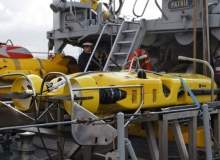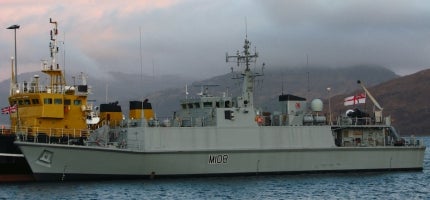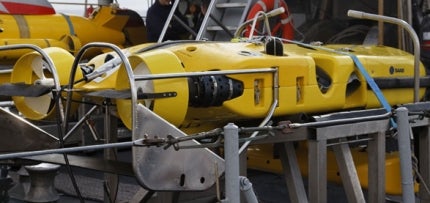
Much like their land-based counterparts, the IED, naval mines represent a clear and present danger to modern seafaring fleets. Difficult to dispose of but cheap to deploy, mines have been and continue to be a useful means of denying access to waters.
The Royal Navy’s response to naval mines currently consists of Hunt-Class minehunter and minesweeper vessels and Sandown-Class minehunter ships, specialist vessels solely designed to counter this threat.
The need to replace the aging Hunt and Sandown mine countermeasure vessels, which have been in service with the Royal Navy since 1979 and 1989 respectively, has predicated the need for a vessel capable of fulfilling multiple capabilities. Pooling together resources and increasing the efficiency of one class of vessel has resulted in the potential combination of mine countermeasures and ocean hydrographic capabilities.

Sandown-Class mine hunting vessels have been in service with the UK Royal Navy since 1989, but 2010’s Strategic Defense and Security Review made it clear the vessels needs replacing.
A brief history of hydrography
The notion of combining hydrographic, mine countermeasure and patrol capabilities into one vessel has been debated for some time.
In March 2010, the UK Government formed the mine countermeasure, hydrography and patrol capability programme, previously labelled as the C3 variation of a future surface combatant, which envisioned the creation of eight ships, each with a displacement of between 2,500 and 3000t.
The Strategic Defence and Security Review, released in October 2010, confirmed that both the Hunt and Sandown Class of vessels were to be replaced with a programme capable of various roles.
The Mine Countermeasure, Hydrographic, Patrol Craft (MHPC) project could feasibly replace four types of vessel with one larger class, with Echo and River vessels joining the Hunt and Sandown in being replaced by the future C3 vessel.
Shaping the countermeasure vessel of the future
Speaking at the UK Ministry of Defence’s Science and Technology Laboratory’s All At Sea event, held in February 2012, Royal Navy commodore Richard Mason reaffirmed commitment to such a project, citing the continued exploration into creating such a vessel after years of research.
Commodore Mason also confirmed that operational drivers are almost certain to shape future vessels, with the Royal Navy’s future vision of combat focused on contested, congested, cluttered and constrained waters, pointing towards the possibility of following the US’s lead and focusing on smaller, more efficient vessels, such as the US Navy’s LCS programme.
With it becoming increasingly apparent that Queen Elizabeth Class carriers are to be the last bespoke-designed vessels which the Royal Navy will build, commercially developed and proven off-the-shelf technologies could yet shape the programme, in an attempt to keep costs within tight budgetary constraints.
Whichever technology is used, the capabilities of the MCM/Hydrography vessels will remain largely the same. The use of autonomous and onboard sensors is being explored, as is continual mapping of areas and improvements to hydrographic tasking in order to assist in the detection of mines. Other nations, such as France and the US, are opting for a similar operational output and are investigating the use of related technology, which the UK could take inspiration from.
Taking inspiration from Swordfish

France’s Espadon (Swordfish) USV, the culmination of the SLAMF programme, has been designed to detect and dispose of mines at sea without risking the lives of servicemen. Image courtesy of the DGA.
One such avenue which is likely to be explored is the use of unmanned systems, enabling the detection and disposal of mines without placing soldiers in harm’s way. One such programme that has explored this possibility is France’s Système de Lutte Anti-Mines Futur (SLaMF), which culminated in the development of the Espadon (Swordfish) USV.
Launched in December 2010, the Swordfish unmanned surface vehicle demonstrator was developed by a group comprised of DCNS, Thales and ECA following a contract awarded in July 2009 by the French General Directorate for Armament (DGA). The 17m-long vessel has a displacement capacity of 25t and is fitted with towed array sonar and smaller submarine drones, used to conduct mine-hunting operations.
Alain Hetet, SLaMF Unity Management operations of naval armament manager, said: "In hazardous areas, the use of robotics allows us to gain more time while approaching the mine."
The programme focuses around one vessel, possibly a catamaran, acting as a ‘mothership’ to two smaller unmanned vessels, which can be launched to dispose of mines that are detected. The larger ship would be kept at a safe distance, but also be capable of launching unmanned aerial vehicles to help relay communications between the two vessels.
Sea trials carried out on behalf of the French Navy and DGA have been underway and are expected to continue into 2012, while Alain Hetet expects the Swordfish to be phased into operational capability from 2018.
Unmanned and underwater advances: shaping defence trends
Advances in unmanned technology is shaping defence trends across the board, with the use of UAVs for reconnaissance amounting to 33% of the total number of military aircraft flights in Iraq and Afghanistan by 2011.
The increasing use of unmanned systems in the fields of oil and natural gas exploration are furthering the development of underwater detection technologies, such as synthetic aperture sonar, which also fits in with the Royal Navy’s desire of using pre-developed and proven technologies, in order to reduce costs, over bespoke systems.
The Royal Navy also picked up expertise in mapping troublesome locations through its work with coalition forces of mapping Umm Qasr Port during Operation Enduring Freedom. Explicit use of unmanned underwater vehicles in the hydrographic mapping of the port enabled mines to be located before a 200-yard wide channel was declared safe in March 2008.
Should the Royal Navy take inspiration from France’s Swordfish project, the technology to successfully develop a fleet of Mine Countermeasure, Hydrographic and Patrol vessels is clearly available.



